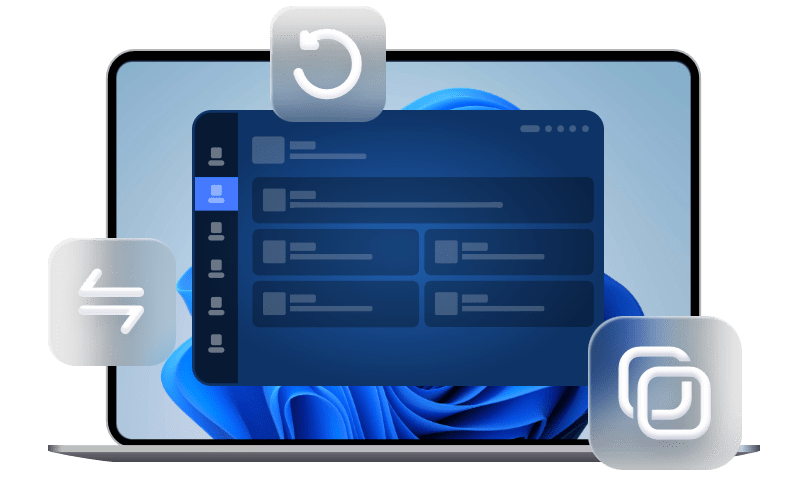Time Machine Equivalent for Windows 10/11
This article comprehensively covers all possible Time Machine like software for Windows 10 or 11, allowing you to find the best option with detailed step-by-step guides. Scroll down to explore more!
Ever envy how Mac users can set up Time Machine and forget about it, knowing their data is automatically protected? That "set-it-and-forget-it" peace of mind doesn't have to be exclusive to Apple.
Windows offers several built-in software deliver an identical and often more powerful automated backup experience. You can also consider using third-party software. We’ll compare them all to help you find the best Time Machine equivalent for Windows 10 or 11 easily.
What Makes a True “Time Machine” for Windows?
Time Machine is macOS's built-in backup software, continuously protecting your data and entire system. It saves hourly backups for the past 24 hours, daily backups for the past month, and weekly backups for all previous months, allowing you to restore to any point in time. It also deletes oldest backups when the disk is full.
The Windows Equivalent isn't a single feature but a combination of built-in tools - File History backs up users' data and keeps multiple versions, and Backup and Restore (Windows 7) creates a system image, or a dedicated alternative for Time Machine - third-party backup software like AOMEI Backupper.
Top Time Machine for Windows - AOMEI Backupper
AOMEI Backupper Professional is one of the best Time Machine equivalents for Windows 10 or 11, featuring an intuitive interface and offering users more powerful features.

- Optional Backup Types: Choose between file backup, system backup, disk backup, or partition backup.
- Automatic Scheduling: Set your schedule backup once - it runs quietly in the background without intervention.
- Auto & space-saving: Include incremental backups, compression, splitting, etc., to minimize image file sizes and thus reduce backup space.
- Multiple Backup Versions: Keep multiple backup versions, allowing you to select the latest one.
- Flexible Backup Storage: Backup to local drives, external disks, NAS, network share, or cloud storage.
- More advanced features: Include automatic cleanup, SSD Alignments, Universal Restore, Edit Partitions, etc., to boost performance and make full use of disk space.
How to Create Time Machine Backup for Windows 10/11
Download and open Time Machine like software for Windows - AOMEI Backupper. On the deep blue screen, click Backup to access all the backup solutions, e.g., File Backup, System Backup, Disk Backup, etc., and back up what you want.
You’ll be asked to select the source and destination during the process. Just click Select/Add Source to select files/folders, partitions, or disks. The OS and boot-related partitions will be included automatically if you click System Backup previously.
Also, you’ll see “Schedule”, “Options”, and “Backup Scheme”, allowing you to create “set-and-forget” backups, keep multiple backup copies, and always ensure sufficient space. Set it up and click Start Backup.
Schedule: It includes 7 options, from daily to monthly, one-time, and event triggers. You can even set it to wake up your computer to run scheduled tasks and then shut down afterward.
Backup Scheme: It consists of backup and cleanup methods - backup only changed files, significantly reducing backup time and space, or delete old backups automatically to free up more space.
Options: It enables compression, splitting, and intelligent sector backup to reduce the size of image files automatically. All of them are adjustable. You can also set email notification, comments, and encryption.
FAQs About Windows Time Machine
1. Is there an exact Time Machine equivalent for Windows?
No, Windows doesn't have a single built-in feature that perfectly matches Time Machine. However, you can combine File History - for automatic file versioning with Backup and Restore (Windows 7) - for full system protection, or by using more powerful third-party backup software like AOMEI Backupper.
2. What's the closest built-in Windows feature to Time Machine?
File History is the closest native option. It automatically backs up versions of your files in Users folders (e.g., Downloads, Documents, Videos, etc.) every hour and lets you browse through previous versions. However, it doesn't backup your entire system or applications like Time Machine does.
3. Can I create bootable backups like Time Machine on Windows?
Yes, but not with basic tools. You'll need either Backup and Restore (Windows 7) or third-party software like AOMEI Backupper. These can create complete, bootable copies of the entire system for full disaster recovery.
4. How often should automated Windows backups run?
For true Time Machine-like protection:
- File backups: Every 1-4 hours for active documents
- System backups: Once daily or weekly
- Full system images: Once a month
Most backup software lets you set different schedules for different types of backups.
5. What's the best way to restore files from Windows backups?
It depends on what you used:
- File History: Right-click any folder > Restore previous versions
- Backup and Restore (Windows 7): Boot from the installation disc or recovery drive and perform System Image Recovery.
- Third-party tools: Restore files, systems, partitions, or disks as needed. Typically, it has an "Explore Image" feature to browse and restore individual files.
Conclusion
Windows does not provide a Time Machine equivalent for Windows 10 or 11 unless you combine File History and Backup and Restore (Windows 7). Using this method, it's not easy to manage the backup process, let alone restore operations.
We recommend using more powerful third-party backup software, such as AOMEI Backupper. It integrates all the backup solutions and multiple features, making the entire process simple and efficient.

